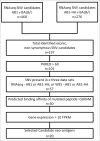Strong spontaneous tumor neoantigen responses induced by a natural human carcinogen
- PMID: 26140232
- PMCID: PMC4485777
- DOI: 10.1080/2162402X.2015.1011492
Strong spontaneous tumor neoantigen responses induced by a natural human carcinogen
Abstract
A key to improving cancer immunotherapy will be the identification of tumor-specific "neoantigens" that arise from mutations and augment the resultant host immune response. In this study we identified single nucleotide variants (SNVs) by RNA sequencing of asbestos-induced murine mesothelioma cell lines AB1 and AB1-HA. Using the NetMHCpan 2.8 algorithm, the theoretical binding affinity of predicted peptides arising from high-confidence, exonic, non-synonymous SNVs was determined for the BALB/c strain. The immunoreactivity to 20 candidate mutation-carrying peptides of increased affinity and the corresponding wild-type peptides was determined using interferon-γ ELISPOT assays and lymphoid organs of non-manipulated tumor-bearing mice. A strong endogenous immune response was demonstrated to one of the candidate neoantigens, Uqcrc2; this response was detected in the draining lymph node and spleen. Antigen reactive cells were not detected in non-tumor bearing mice. The magnitude of the response to the Uqcrc2 neoantigen was similar to that of the strong influenza hemagglutinin antigen, a model tumor neoantigen. This work confirms that the approach of RNAseq plus peptide prediction and ELISPOT testing is sufficient to identify natural tumor neoantigens.
Keywords: HA, hemagglutinin; MCA, methylcholanthrene; NGS, next-generation sequencing; RNAseq; SNV, single nucleotide variant.; dLN, lymph node draining the tumor; epitope prediction; mesothelioma; neoantigen.
Figures



References
-
- Castle JC, Kreiter S, Diekmann J, Löwer M, van de Roemer N, de Graaf J, Selmi A, Diken M, Boegel S, Paret C, et al.. Exploiting the mutanome for tumor vaccination. Cancer Res 2012. 72:1081-1091; PMID:; http://dx.doi.org/10.1158/0008-5472.CAN-11-3722. - DOI - PubMed
-
- Matsushita H, Vesely MD, Koboldt DC, Rickert CG, Uppaluri R, Magrini VJ, Arthur CD, White JM, Chen YS, Shea LK, et al.. Cancer exome analysis reveals a T-cell-dependent mechanism of cancer immunoediting. Nature 2012. 482:400-404; PMID:; http://dx.doi.org/10.1038/nature10755. - DOI - PMC - PubMed
-
- Gubin MM, Zhang X, Schuster H, Caron E, Ward JP, Noguchi T, Ivanova Y, Hundal J, Arthur CD, Krebber WJ, et al.. Checkpoint blockade cancer immunotherapy targets tumour-specific mutant antigens. Nature 2014. 515:577-581; PMID:; http://dx.doi.org/10.1038/nature13988. - DOI - PMC - PubMed
-
- Snyder A, Makarov V, Merghoub T, Yuan J, Zaretsky JM, Desrichard A, Walsh LA, Postow MA, Wong P, Ho TS, et al.. Genetic basis for clinical response to CTLA-4 blockade in melanoma. N Engl J Med 2014. 371:2189-2199; PMID:; http://dx.doi.org/10.1056/NEJMoa1406498. - DOI - PMC - PubMed
Publication types
LinkOut - more resources
Full Text Sources
Other Literature Sources
Molecular Biology Databases
Miscellaneous
